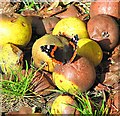1
Red Admiral (Vanessa atalanta) feasting on pear
There were about 10 or 15 of them feasting on the pears that had dropped from a tree in a neighbouring garden.
The Red Admiral is a frequent visitor to gardens throughout the British Isles and one of our most well-known butterflies. This butterfly is unmistakable, with the velvety black wings intersected by striking red bands.
This butterfly is primarily a migrant to our shores, although sightings of individuals and immature stages in the first few months of the year, especially in the south of England, mean that this butterfly is now considered resident. This resident population is considered to only be a small fraction of the population seen in the British Isles, which gets topped up every year with migrants arriving in May and June that originate in central Europe. Unfortunately, most individuals are unable to survive our winter, especially in the cooler regions of the British Isles. http://www.ukbutterflies.co.uk/species.php?species=atalanta. For a wider view of this location see > http://www.geograph.org.uk/photo/2612582.
Image: © Evelyn Simak
Taken: 22 Sep 2011
0.02 miles
2
Red Admiral (Vanessa atalanta)
The Red Admiral is a frequent visitor to gardens throughout the British Isles and one of our most well-known butterflies. This butterfly is unmistakable, with the velvety black wings intersected by striking red bands.
This butterfly is primarily a migrant to our shores, although sightings of individuals and immature stages in the first few months of the year, especially in the south of England, mean that this butterfly is now considered resident. This resident population is considered to only be a small fraction of the population seen in the British Isles, which gets topped up every year with migrants arriving in May and June that originate in central Europe. Unfortunately, most individuals are unable to survive our winter, especially in the cooler regions of the British Isles. http://www.ukbutterflies.co.uk/species.php?species=atalanta. For a wider view of this location see > http://www.geograph.org.uk/photo/2612582.
Image: © Evelyn Simak
Taken: 22 Sep 2011
0.03 miles
3
Public footpath past the church, Weybread
Actually the driveway to cottages beside the churchyard but this short section of it serves as a public footpath, leading further to the north.
Image: © Evelyn Simak
Taken: 22 Sep 2011
0.04 miles
4
Old Wooden Footpath Sign
Old wooden footpath sign at Weybread, Suffolk.
Image: © Keith Evans
Taken: 27 Jun 2013
0.04 miles
5
Footpath to One Eyed Lane
Image: © Geographer
Taken: 9 Dec 2011
0.04 miles
6
Footpath to One Eyed Lane
Off Church Lane
Image: © Geographer
Taken: 9 Dec 2011
0.04 miles
7
St. Andrew's church at Weybread
The church dates back to the Norman period but much of what is seen today is Victorian restoration. It stands in a pretty setting by the Hall and a moated farm.
Image: © Robert Edwards
Taken: 1 Mar 2007
0.05 miles
8
Holiday House, Weybread
Image: © Evelyn Simak
Taken: 22 Sep 2011
0.05 miles
9
St.Andrew's Church, Church Lane, Weybread
Taken from the entrance to Weybread Hall
http://www.suffolkchurches.co.uk/weybread.htm
Image: © Geographer
Taken: 9 Dec 2011
0.05 miles
10
Weybread St Andrew's church, Suffolk
The round western tower is out of proportion to the rest of the church. The clerestory, with its lofty windows, is the culprit. The whole church has in the past undergone such extensive restoration by the Victorians that little is worthy of note. The porch is a simple one with stone and flint panelled flushwork. The font is modern, but the 15th century font remains in the south aisle with the bowl reduced to half its original height. The rood-loft stairs are still open and the corbels that support the roof are all different, as are the bench ends. There are two piscinas, the one in the south aisle is 13th century and that in the chancel is 100 years later. There is a very recent memorial to Sergeant Alfred Ablett, the first man from Suffolk to be awarded the Victoria Cross.
Image: © Adrian S Pye
Taken: 11 Feb 2008
0.06 miles











